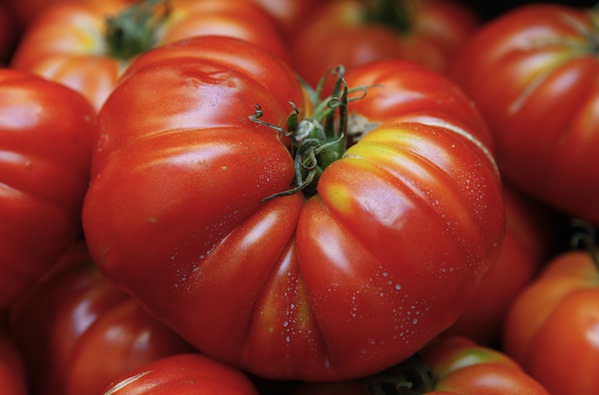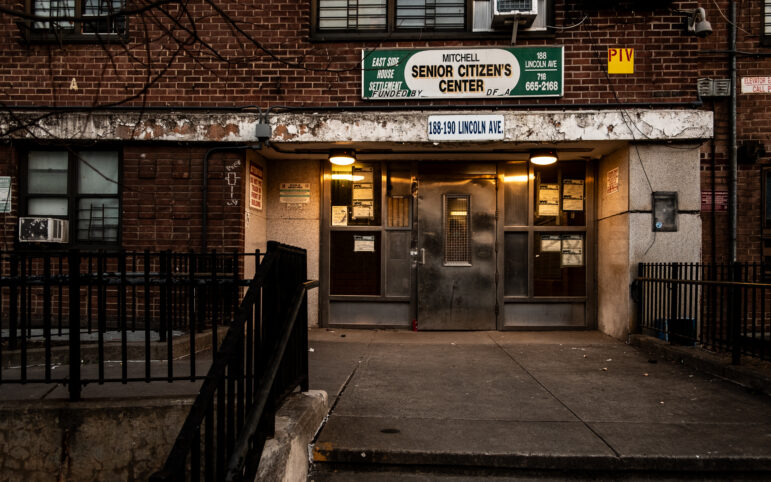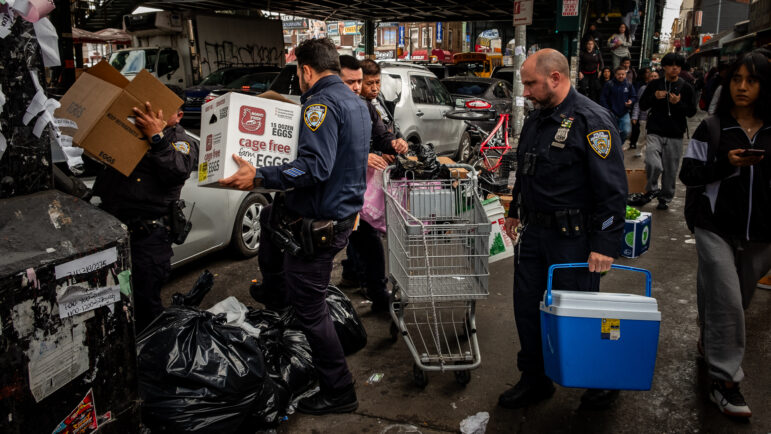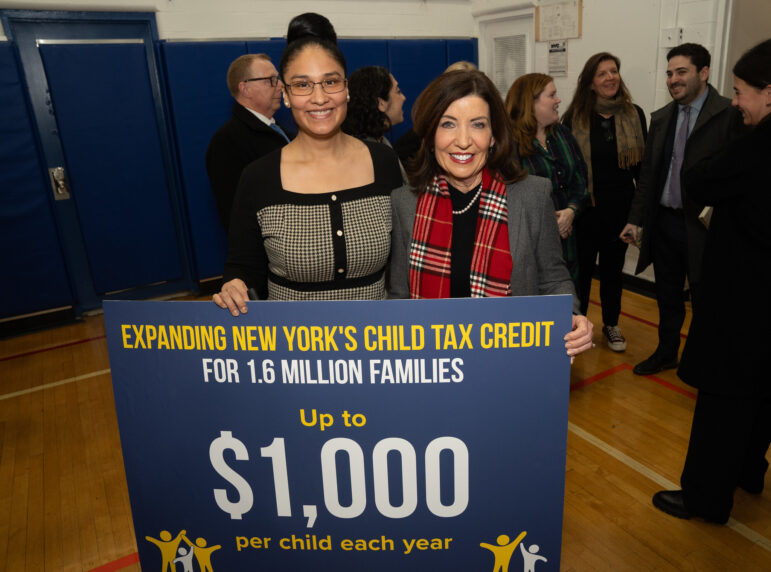
Photo by: Marc Fader
Heirloom tomatoes from Upstate New York await pickup by CSA members at the Tribeca CSA.
Sometime in the last year, New York City reached a milestone: More than one-quarter of its adult residents are now receiving food stamps. Thanks in large part to the outreach efforts of the Bloomberg administration–with an added boost from the crappy economy–1.7 million New York City residents are now receiving food stamps (or Supplemental Nutrition Assistance Program benefits, as they’ve been officially known since 2008), up from 800,000 at its low point in the final month of the Giuliani Administration in December 2001.
Finding places to effectively spend those food stamps is another story. A large percentage of the 1.7 million occupy food deserts, neighborhoods where bodegas and other high-priced, low-quality stores are the only options, and fresh fruit and vegetables may be only a rumor. And despite the recent explosion of farmers markets, community supported agriculture projects and the city’s own new Green Carts, many of these food sources still remain off-limits to food-stamp shoppers.
Farmers markets might have a reputation as a haven for upscale foodies, but it was not always so. In the 1990s, say nutrition experts, food stamps were widely spent at the farmers markets that were then available. That all came to a screeching halt in 1999 with the advent of Electronic Benefits Transfer (EBT) cards, which Congress mandated that states use in place of paper food stamp coupons as an anti-fraud measure.
“When they did away with paper food stamps and went to the EBT card, it pretty much wiped out the use of food stamps in the farmer’s market, which was very robust,” says Marcel Van Ooyen, director of GrowNYC, which oversees the city’s 51 designated Greenmarkets. “Since then, there have been real struggles to try to connect shoppers with farmer’s markets.”
New York has been slowly clawing its way back toward pre-EBT levels of food access for low-income shoppers, thanks to a combination of city and state initiatives. In 2002, the state agriculture department got federal funding for a pilot project to provide wireless EBT readers to New York markets, a project that went full-scale in 2006. (The federal government provides only wired machines, which are useless to an outdoor market.) This year, for the first time, a majority of the city’s 51 Greenmarkets accept EBT cards, which can be used to purchase wooden tokens at a central kiosk; the tokens, in turn, can be redeemed at any stand throughout the market.
The result has been a surge of low-income shoppers to markets. According to GrowNYC, city markets did $250,000 in EBT sales last year, up from a mere $1,000 in 2005–and food-stamp transactions are expected to rise in 2010, with the number of EBT-friendly markets up from 23 to 27. (GrowNYC says it plans to expand EBT acceptance to 40 markets by the end of the summer.) Statewide, farmers markets did $600,000 in food stamp transactions last year, tops in the nation.
Andy Fisher, director of the Oregon-based Community Food Security Coalition–which last week released an extensive report on the difficulties farmers markets face nationwide in accepting SNAP benefits–calls New York City a “beacon for the rest of the nation” in its efforts to increase access for EBT cardholders.
Much of the credit, say food experts, goes to Health Bucks, a coupon program funded by the city Human Resources Administration and run by the city Department of Health and Mental Hygiene. Originally intended to provide incentives for low-income New Yorkers to attend nutrition trainings and health fairs–show up, and get a $2 farmers market coupon for your trouble–the program was transformed several years ago when Van Ooyen proposed handing the coupons out directly at markets. For every $5 in food stamps redeemed, shoppers can get $2 in Health Bucks, which can be used at the market that day or saved for later (but can only be used on fresh fruits or vegetables). The effect was to allow shoppers to stretch their food dollars by 40 percent over what they’d get at a standard supermarket.
“We know that there are certain areas of the city that have the lowest consumption of fruits and vegetables, and those are also the areas of the city with the highest rates of obesity and diabetes,” says Sabrina Baronberg, deputy director of the city health department’s physical activity and nutrition program. “We know that the demand is there: People want more access to fruits and vegetables,” she says. “What we need to do is change the environment to make it easier for them to purchase healthier foods.” The city took another step in that direction this year by getting a federal waiver to provide wireless EBT terminals to 15 of the city’s 650 newly licensed Green Cart street vendors.
Still, low-income access to fresh produce remains a work in progress. Even with wireless card readers, markets have to dedicate staff to dispense tokens and Health Bucks–an approach a GrowNYC spokesperson calls “not sustainable in the long-term.” And while city funding allows for about 100,000 Health Bucks to be distributed each year, that can only accommodate about $250,000 in annual food-stamp sales–meaning the fund is already effectively tapped out. “We’ve tried to limit the number of farmer’s markets to ensure that [the supply of Health Bucks] lasts the entire season,” says Baronberg. “Right now, we’re at 60 markets, but there are many more markets that accept food stamps that could offer Health Bucks. But because of the limited funding, we can’t expand to all of them.”
For CSAs–buying clubs where members chip in to buy shares of the entire output of a single farm for a season–there are different challenges. Being mostly sited indoors, they can make do with wired terminals, which they can get from USDA just by filling out a form. But as volunteer-run customer groups, most CSAs are required by USDA to partner with a community-based organization that can serve as the legal entity that accepts food stamps. And even with the aid of Just Food, an umbrella group that offers an online resource center for CSA organizers, some startups say they can be daunted by paperwork that asks whether you’re a “store” or a “farmers market.” Currently only 20 out of the city’s more than 90 CSAs accept EBT cards.
Joel Berg of the New York City Coalition Against Hunger, which runs three CSAs targeted specifically at low-income families (the third, in Crown Heights, opened last month) adds that “food stamp access is only part of the puzzle of making these more available to low-income people.” Many CSAs normally require up-front payments for a season’s groceries, so that farmers can pay their costs ahead of the growing season. Since food stamps are only replenished monthly, organizers must adjust payment schedules if they want to accommodate EBT users. One solution that some have turned to is to cover up-front costs with a revolving loan fund, which is replenished by EBT charges as the season goes on.
And even with food stamps, many shoppers may not be able to afford CSA prices. The Coalition Against Hunger heavily subsidizes shares for low-income members out of its own pocket. Other CSAs use sliding scales, either hiking prices for higher income members or doing independent fundraising to cover low-income members.
Then there’s also the ever-tenuous hold that many food stamp recipients have on their government benefits, even in the age of Bloomberg. Lauren Melodia, whose Bed-Stuy Buyers Club has accepted EBT cards since soon after its inception in 2005, says it’s been frustrating to see families have to drop out after they’ve had their food stamp benefits cut off. “We’ve had some really great members who have lost their food stamps in the middle of the season.”
Other obstacles, says Berg, include that “low-income people have less storage space and less refrigerator space,” as well as less flexible schedules to do pickups. (Melodia says her group recruits volunteers to do home delivery to members who can’t get to the pickup location on time.) And where a well-off CSA member might be able to tolerate the occasional inefficiencies of CSAs–ending up one week with a crate of uneaten leeks, for example–that can be an unaffordable luxury for someone living hand to mouth. “They’re a great model,” Berg says, “but they’re not for everyone.”
“Having the ability to accept food stamps isn’t really going to change your membership that much,” agrees Melodia. One challenge, she says, is that what may be a selling point for higher-income shoppers–making a promise to support a small farmer for a year–may seem like too big a commitment for a family with less resources. “So we’ve had to adjust our messaging a little bit.”
The real need, though, says Melodia, is for more dedicated funding, both for educational and outreach programs and for administrative support. “CSAs have something to offer in their communities that other community food providers don’t really have,” she says. “But I think the needs of low-income families require more support from a community supported agriculture project than a volunteer group can provide.”








